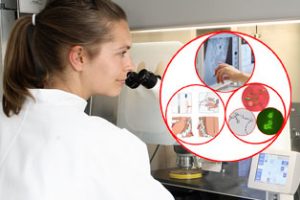Infections are the cause of many ailments and diseases. Germs can imperceptibly disturb the physical balance long before a disease breaks out. Chronic ailments can develop. Their actual causes can often not be found without careful microbiological analysis.

Infections often go undetected or are neglected before the onset of a disease. However, many of the apparent ailments – such as digestion, sleep, concentration, headaches and joint pains, fluctuations in body temperature, skin disorders – can be signs of infection.

Some germs generally make people sick. Therefore, for instance, infections with pathogenic bacteria like e.g. Helicobacter pylori and yeasts e.g. from the genus Candida should be treated by a doctor. Other germs also cause discomfort when they appear in the wrong places in the body. Medicine then speaks of “incorrect colonisation”. For instance, there are germs that belong to the intestinal flora (Escherichia coli), but cause diseases in the bladder and kidneys.
An often underestimated reason for repeated cystitis is indigestion. Especially with a tendency to irregular bowel movements or constipation (constipation), germs can enter the bloodstream through the intestinal walls (here referred to as persorption). The germs can then be filtered through the kidneys and flushed into the bladder, making the epithelial cells of the intestinal mucosa permeable and thus opening and facilitating the way for other pathogens into the bloodstream.

Generally speaking, the non-observance and non-treatment of pathogenic yeasts has a number of consequences. The misinterpretation of the great health damage caused by the genus Candida (e.g. its species albicans, tropicalis, famata, glabrata, guilliermondii, krusei, parapsilosis) is a widespread problem. This can lead to acute or severe illnesses over many years.
Due to the high prevalence rate, a kind of “habituation” has eventuated to the occurrence of pathogenic yeasts in humans. Even experts are often not surprised with the fact that the immune system is already able to “cope with the fungi”. However, this is extremely questionable from a medico-scientific point of view.
In more than 2,000 publications in the middle of the last century, Prof. Dr. Dr. H. H. Rieth together with colleagues at the University Clinic Hamburg-Eppendorf pointed out the danger of yeasts with the help of many examples.
Even though little research is done in this field today, there are occasional publications that clearly show how dangerous this misjudgement is, especially with regard to the immune system.

With the example of Candida glabrata, research (cf. Seider, K., S. Brunke et al. (2011): The facultative intracellular pathogenic Candida glabrata subverts macrophage cytokine production and phagolysosome maturation. J Immunol 187(6): 3072–86 (2011)), shows that this yeast proliferates directly in the human immune system in the macrophages (i.e. in the scavenger cells) and destroys them (Brunke, Sascha et al. (2011): Evasion and adaptation mechanisms of Candida glabrata during interaction with macrophages. DMykG, Mycology Forum, Medical Mycology in Clinic and Practice. Issue 3/11 (2011), p. 23). The macrophages (also called phagocytes) are an important part of the immune defence. But parasites can also cause many ailments.
In order to avoid complications and for targeted causal medical care, it is therefore necessary to carefully incorporate microbiology, which systematically detects parasites, pathogenic yeasts, bacteria and incorrect colonisations. The correct specimen collection plays an important role here. For more information and research visit our Literature Database Microbiology.
Disturbances of organ functions, digestion, the immune system and infections are in a reciprocal relationship of cause and effect:
On the one hand, infections, for instance, weaken the spleen function (and other organs). On the other hand, a weak and “overstrained” spleen promotes susceptibility to infections. As a consequence, body develops complex disturbances of the organ activities.
Taking the careful involvement of infections into account, a comprehensive clarification of the actual causes of ailments and illnesses is important. It forms the basis for the respective combination of possibilities with which the causes can be treated as properly and as gently as possible.

Repeated use of drugs can be the result of a lack of medical quality assurance. There may be complications and discontinuations of therapy, if unsystematic procedures fail to achieve their goals. Therefore, guidelines of diagnostics and treatment are of great importance.
Special attention is also paid to the interplay between infections with parasites, bacteria and yeasts and viruses. In particular infections with the
More than 2,000 publications in the middle of the last century show that modern medicine is confronted with a multitude of pathogens. These can only be treated sustainably by consistent causal medical care.

The “immune system” is often not strengthened as intended due to the accumulation of supposedly controllable pathogens, but lacks the “capacity” to maintain effective protection or to counter other new infections.
A good physical balance does not comprise of a balance of pathogens. The aim of a comprehensive, sustainable and subsequently preventive causal medical care is a relieved body with an immune system that is not constantly overtaxed by incorrect colonisations or pathogens – and whose organs and organ functions are not impaired by it.
The “immune system” is often not strengthened by the accumulation of supposedly controllable pathogens as assumed, but lacks “capacities” to maintain effective protection or to counter other, new infections.
Good physical balance does not consist of a balance of pathogens. The goal of complete, sustainable and subsequently preventive causal medicine is a relieved body with an immune system that is not constantly overwhelmed by incorrect colonization or pathogens – and whose organs and organ functions are not impaired by them.